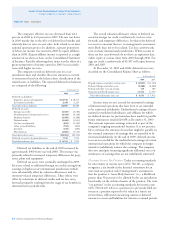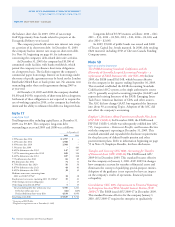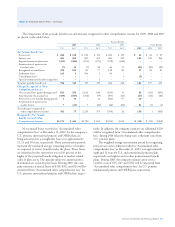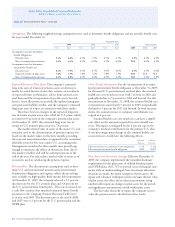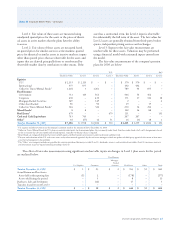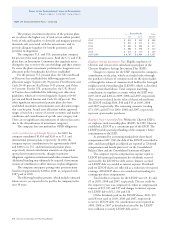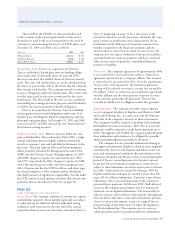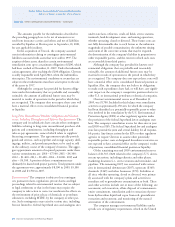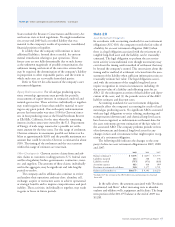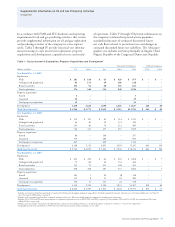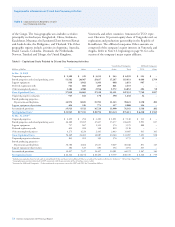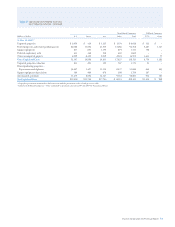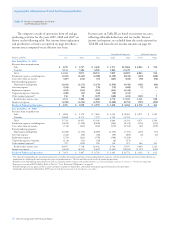Chevron 2009 Annual Report Download - page 66
Download and view the complete annual report
Please find page 66 of the 2009 Chevron annual report below. You can navigate through the pages in the report by either clicking on the pages listed below, or by using the keyword search tool below to find specific information within the annual report.
64 Chevron Corporation 2009 Annual Report
FS-PB
Pension Benefits Other
U.S. Int’l. Benefits
2010 $ 855 $ 242 $ 208
2011 $ 851 $ 271 $ 213
2012 $ 861 $ 284 $ 217
2013 $ 884 $ 296 $ 222
2014 $ 913 $ 317 $ 229
2015–2019 $ 4,707 $ 1,969 $ 1,197
Employee Savings Investment Plan Eligible employees of
Chevron and certain of its subsidiaries participate in the
Chevron Employee Savings Investment Plan (ESIP).
Charges to expense for the ESIP represent the company’s
contributions to the plan, which are funded either through
the purchase of shares of common stock on the open market
or through the release of common stock held in the leveraged
employee stock ownership plan (LESOP), which is described
in the section that follows. Total company matching
contributions to employee accounts within the ESIP were
$257, $231 and $206 in 2009, 2008 and 2007, respectively.
This cost was reduced by the value of shares released from
the LESOP totaling $184, $40 and $33 in 2009, 2008
and 2007, respectively. The remaining amounts, totaling
$73, $191 and $173 in 2009, 2008 and 2007, respectively,
represent open market purchases.
Employee Stock Ownership Plan Within the Chevron ESIP is
an employee stock ownership plan (ESOP). In 1989, Chevron
established a LESOP as a constituent part of the ESOP. The
LESOP provides partial prefunding of the company’s future
commitments to the ESIP.
As permitted by accounting standards for share-based
compensation (ASC 718), the debt of the LESOP is recorded as
debt, and shares pledged as collateral are reported as “Deferred
compensation and benefit plan trust” on the Consolidated
Balance Sheet and the Consolidated Statement of Equity.
The company reports compensation expense equal to
LESOP debt principal repayments less dividends received
and used by the LESOP for debt service. Interest accrued
on LESOP debt is recorded as interest expense. Dividends
paid on LESOP shares are reflected as a reduction of retained
earnings. All LESOP shares are considered outstanding for
earnings-per-share computations.
Total credits to expense for the LESOP were $3, $1 and
$1 in 2009, 2008 and 2007, respectively. The net credit for
the respective years was composed of credits to compensation
expense of $15, $15 and $17 and charges to interest expense
for LESOP debt of $12, $14 and $16.
Of the dividends paid on the LESOP shares, $110, $35
and $8 were used in 2009, 2008 and 2007, respectively,
to service LESOP debt. No contributions were required in
2009, 2008 or 2007 as dividends received by the LESOP
were sufficient to satisfy LESOP debt service.
Note 21 Employee Benefit Plans – Continued
The primary investment objectives of the pension plans
are to achieve the highest rate of total return within prudent
levels of risk and liquidity, to diversify and mitigate potential
downside risk associated with the investments, and to
provide adequate liquidity for benefit payments and
portfolio management.
The company’s U.S. and U.K. pension plans comprise
84 percent of the total pension assets. Both the U.S. and U.K.
plans have an Investment Committee that regularly meets
during the year to review the asset holdings and their returns.
To assess the plan’s investment performance, long-term asset
allocation policy benchmarks have been established.
For the primary U.S. pension plan, the Chevron Board
of Directors has established the following approved asset
allocation ranges: Equities 40–70 percent, Fixed Income and
Cash 20–60 percent, Real Estate 0–15 percent, and Other
0–5 percent. For the U.K. pension plan, the U.K. Board
of Trustees has established the following asset allocation
guidelines, which are reviewed regularly: Equities 60–80
percent and Fixed Income and Cash 20–40 percent. The
other significant international pension plans also have
established maximum and minimum asset allocation ranges
that vary by plan. Actual asset allocation within approved
ranges is based on a variety of current economic and market
conditions and consideration of specific asset category risk.
There are no significant concentrations of risk in plan assets
due to the diversification of investment categories.
The company does not prefund its OPEB obligations.
Cash Contributions and Benefit Payments In 2009, the
company contributed $1,494 and $245 to its U.S. and
international pension plans, respectively. In 2010, the
company expects contributions to be approximately $600
and $300 to its U.S. and international pension plans,
respectively. Actual contribution amounts are dependent
upon plan-investment returns, changes in pension
obligations, regulatory environments and other economic factors.
Additional funding may ultimately be required if investment
returns are insufficient to offset increases in plan obligations.
The company anticipates paying other postretirement
benefits of approximately $208 in 2010, as compared with
$187 paid in 2009.
The following benefit payments, which include estimated
future service, are expected to be paid by the company in the
next 10 years:
Notes to the Consolidated Financial Statements
Millions of dollars, except per-share amounts


